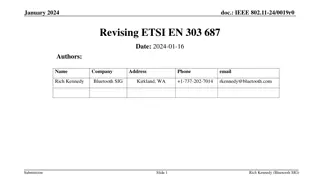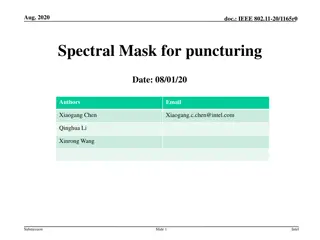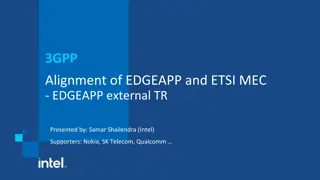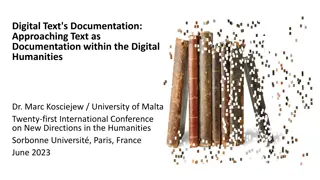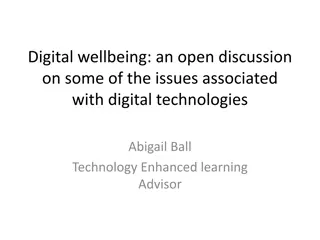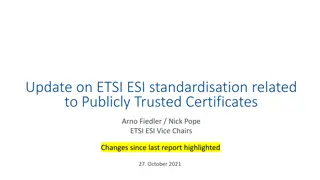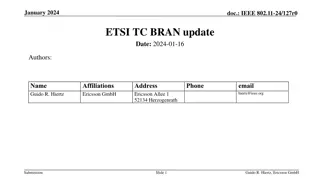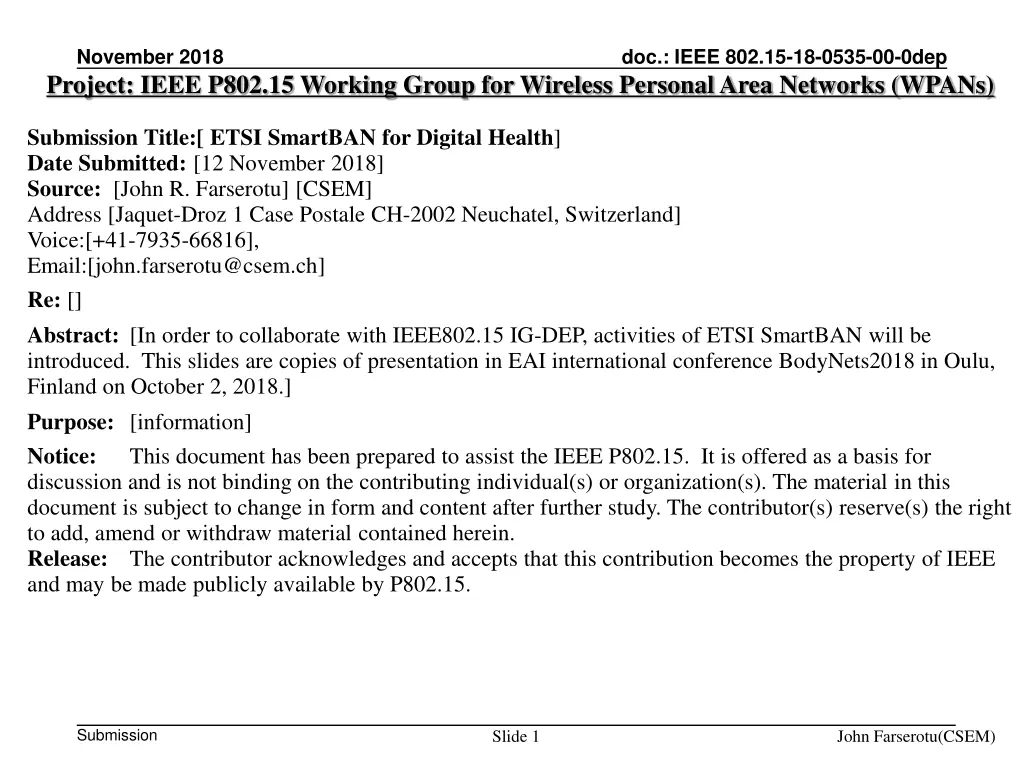
SmartBAN for Digital Health: Advancements in Wireless Personal Area Networks
Discover the latest developments in wireless personal area networks with SmartBAN technology focusing on digital health applications. Explore how SmartBAN addresses challenges in interoperability, low power consumption, security, and more to enhance connectivity in smart environments for health and medical purposes.
Download Presentation

Please find below an Image/Link to download the presentation.
The content on the website is provided AS IS for your information and personal use only. It may not be sold, licensed, or shared on other websites without obtaining consent from the author. If you encounter any issues during the download, it is possible that the publisher has removed the file from their server.
You are allowed to download the files provided on this website for personal or commercial use, subject to the condition that they are used lawfully. All files are the property of their respective owners.
The content on the website is provided AS IS for your information and personal use only. It may not be sold, licensed, or shared on other websites without obtaining consent from the author.
E N D
Presentation Transcript
November 2018 doc.: IEEE 802.15-18-0535-00-0dep Project: IEEE P802.15 Working Group for Wireless Personal Area Networks (WPANs) Submission Title:[ ETSI SmartBAN for Digital Health] Date Submitted: [12 November 2018] Source: [John R. Farserotu] [CSEM] Address [Jaquet-Droz 1 Case Postale CH-2002 Neuchatel, Switzerland] Voice:[+41-7935-66816], Email:[john.farserotu@csem.ch] Re: [] Abstract: [In order to collaborate with IEEE802.15 IG-DEP, activities of ETSI SmartBAN will be introduced. This slides are copies of presentation in EAI international conference BodyNets2018 in Oulu, Finland on October 2, 2018.] Purpose: [information] Notice: This document has been prepared to assist the IEEE P802.15. It is offered as a basis for discussion and is not binding on the contributing individual(s) or organization(s). The material in this document is subject to change in form and content after further study. The contributor(s) reserve(s) the right to add, amend or withdraw material contained herein. Release: The contributor acknowledges and accepts that this contribution becomes the property of IEEE and may be made publicly available by P802.15. Submission Slide 1 John Farserotu(CSEM)
November 2018 doc.: IEEE 802.15-18-0535-00-0dep ETSI SmartBAN for Digital Health John Farseroutu Chair TC SmartBAN, ETSI CESM, Switzerland This slides are copies of presentation in EAI international conference BodyNets2018 in Oulu, Finland on October 2, 2018 Submission Slide 2 John Farserotu(CSEM)
November 2018 doc.: IEEE 802.15-18-0535-00-0dep Introduction The use of wearables and body sensor devices is rapidly growing in the Internet of Things (IoT). Wireless Body Area Networks (BAN) offer a means of connectivity, facilitating the sharing of data, interaction and interoperability within smart environments, such as smart homes and living environments, as well as, emerging automotive and aerospace applications. SmartBAN started as academic research by European researchers. TC SmartBAN was approved in March 2013. SmartBAN aims at a smart solution for BAN with improved and dedicated performance for medical, health improvement and sport and leisure applications, further to existing BAN standards. It covers: communication and the associated physical layer (PHY) and the Medium access control (MAC) layer network layer, security, Quality-of-Service (QoS) and provision of generic applications and services, a star network around a smart hub such as a handset or a watch, with the option for a multi-hop relay. Submission John Farserotu(CSEM) Slide 3
November 2018 doc.: IEEE 802.15-18-0535-00-0dep The challenges The challenges for BAN include interoperability in heterogeneous use cases, low power, low latency, security, robust operation and the ability to interact with embedded intelligence in smart environments. To meet these challenges, ETSI Technical Committee (TC) SmartBAN (SmartBAN) aims at the realization of a smart BAN with improved and dedicated performance for medical, health, sport and leisure applications. To address these challenges, SmartBAN Targets a more efficient MAC and PHY, yielding very low latency emergency messaging, very low energy consumption and rapid initial set up time and channel reassignment. Provides additional semantic and data analytic enablers (e.g. semantic discovery, reasoning / rules) and automatic node discovery such as semantic discovery of nodes or composition. Provides added robustness via forward error correction Supports operation across heterogeneous networks with enhanced interoperability / connectivity options, including data, network and semantic interoperability. Submission John Farserotu(CSEM) Slide 4
November 2018 doc.: IEEE 802.15-18-0535-00-0dep SmartBAN network and features SmartBAN design features: Star concept + multi hub relay Efficient MAC and PHY, yielding very low latency emerging messaging, very low energy consumption, very fast initial set up time, channel reassignment Real-time radio channel assignment (subject of further research) Smart: semantic approach, semantic interoperablity, heterogeneity management, IoT compliance, automatic node discovery (e.g. semantic discovery of nodes) 5 Submission John Farserotu(CSEM) Slide 5
November 2018 doc.: IEEE 802.15-18-0535-00-0dep Comparison with other standards Parameter SmartBAN Hub + smart relay coordination BTLE IEEE 802.15.6 System Architecture One hub One hub General system specs Networking communication interoperability (SmartBAN and non-SmartBAN nodes) Smart relay FEC (forward error correction) Initial set up time Spread spectrum hopping Channel reassignment Very low latency emerging messaging Reutilization of scheduled unused time slots (efficiency parameter) Yes No No Yes Yes Fast No Yes Very fast (timeslot) No No Less fast Yes No No No Yes Less fast Yes (in limited cases) Multiple channel Medium (superframe) PHY/MAC Yes No No Low (e.g. long sleep times) Energy consumption/efficiency Low Medium Star concept + multi hub relay (planned) Star concept Network complexity Star concept + relay Semantic approach, semantic interoperability, heterogeneity management, IoT compliance Yes No No Additional semantic and data analytic enablers (e.g. semantic discovery, reasoning/rules) Yes No No Smarts Automatic node discovery (e.g. semantic discovery of nodes, composition) Coexistence management by coordinator Yes Partially No High Low Low Submission John Farserotu(CSEM) Slide 6
November 2018 doc.: IEEE 802.15-18-0535-00-0dep Timeline, progress and milestones achieved Status Number Title Date The group has released the following specifications and reports: TS 103 326 Ver. 1.1.1 Smart Body Area Network (SmartBAN), Enhanced Ultra-Low Power Physical Layer 2015-04-28 TS 103 325 Ver. 1.1.1 Smart Body Area Network (SmartBAN), Low Complexity Medium Access Control (MAC) for SmartBAN 2015-04-28 Published TS 103 378 Ver. 1.1.1 Smart Body Area Networks (SmartBAN), Unified data representation formats, semantic and open data mode 2015-12-11 TR103 395 Ver. 1.1.1 Smart Body Area Network (SmartBAN); Measurements and modelling of SmartBAN Radio Frequency (RF) environment 2016-12-20 TR103 394 Ver.1.1.1 Smart Body Area Networks (SmartBAN); System Description 2018-1-15 DTR/SmartBAN-001 Comparative analysis between SmartBAN and other short-range standards Q4 2018 (draft), Q3 2019 (approval) DTS/SmartBAN-004 - TS 103 327 Smart Body Area Networks (SmartBAN); Service and application standardized enablers and interfaces, APIs and infrastructure for interoperability management Q3 2018 (publication) In preparation RTS/SmartBAN-005r1 TS 103 325 Low complexity MAC and routing for SmartBAN, Draft started (TS 103 325) Q2 2018 (draft), Q1 2019 (approval) RTS/SmartBAN-009r1 - TS 103 378 SmartBAN unified data representation formats, semantic open data model and corresponding ontology Q1 2019 (publication) Submission John Farserotu(CSEM) Slide 7
November 2018 doc.: IEEE 802.15-18-0535-00-0dep PHY-MAC Technical Requirements Technical Requirements for PHY- MAC 1. Ultra Low Power Design HUB/Node Role Sharing HUB takes care of MAC operation functionality as much as possible. Node operation is designed to be minimum. Low complexity/low energy is maintained by exploiting the two-channel approach 2. Timely Accessible Mechanism Emergency Signal Transmission 3. Co-existence Robustness Co-existence between HUBs Automatic interference avoidance between BANs using the same data channel 4. QoS Optimization Mechanism Transmission (re-transmission) at the required level of BER, latency, etc. Smart BAN Solutions Ultra Low Power 2-ch Concept Control Channel (C-ch) Data Channel (D-ch) Timely Accessible Mechanism Co-existence Robustness D-ch Frame Structure QoS Optimization Mechanism C-Beacon C-Beacon C-ch Time D-Beacon D-Beacon IAP SAP TDMA CMP Slotted ALOHA D-ch Time 2-ch Concept and Access Schemes Submission John Farserotu(CSEM) Slide 8
November 2018 doc.: IEEE 802.15-18-0535-00-0dep Data representation and interoperability management A BAN (SmartBAN) data, device, service/application unified semantic and open reference model, with corresponding modular ontology: key element for BANs data/device interoperability, coupled with a XaaS/WoT strategy for semantic interoperability handling, device discovery and composition facilities, data sharing at application level and cross domain use cases handling, eases implementation of automated monitoring/control strategies. A BAN (SmartBAN) global and more integrated IoT reference architecture for secure interaction and access to BAN data & entities: specified on top of the SmartBAN reference model, oneM2M and Multi-Agent based, addresses network/syntactic/semantic interoperability, provides in particular generic service enablers for semantic data sharing/management, embedded semantic analytics (device/edge/fog levels), and distributed monitoring/control operations. Submission John Farserotu(CSEM) Slide 9
November 2018 doc.: IEEE 802.15-18-0535-00-0dep Cooperation with other bodies and demonstration of the technology Cooperation SmartBAN has collaborated with oneM2M and namely contributed to the ITEA3 CareWare project demonstrator (elderly at home support) Clinical tests in partnership with OHS Office d'Hygi ne Sociale Nancy are ongoing. TC SmartBAN s work continues to be promoted via contributions to various bodies both within ETSI and internationally e.g.: oneM2M/SmartM2M (M. Girod-Genet), ERM TG 30 (D. Ansai), AIOTI (M. Girod- Genet), IEC (H. Tanaka, official liaison to IEC systems committee, active assisted living, BT SIG (H. Tanaka), H2020 ACTIVAGE (J. Farserotu) Demonstration of SmartBAN technology will be held at ETSI IoT Week including: Semantic interoperability and SmartBAN reference IoT/oneM2M platform for remote monitoring and control applications (M. Girod-Genet) SmartBAN 2.4GHz PHY (H. Tanaka) Submission John Farserotu(CSEM) Slide 10
November 2018 doc.: IEEE 802.15-18-0535-00-0dep Moving forward near term New Work Item (NWI) on implant communication was initiated in 2018, in cooperation with ETSI ERM TG 30. NWI on security, privacy and trust for SmartBAN is currently being drafted Joint group between ETSI TC SmartBAN and ETSI TC SmartM2M is envisioned for merging and/or aligning the SmartBAN ontology with SAREF* and oneM2M ontologies. SmartBAN Workshop, Connected Things for Wellbeing and Health, at ETSI IoT Week, 22-26 October, at ETSI headquarters, Sophia Antipolis, France. *SAREF: Smart Appliances REFerence ontology Submission John Farserotu(CSEM) Slide 11
November 2018 doc.: IEEE 802.15-18-0535-00-0dep ETSI IoT Week 2018, SmartBAN Workshop, Thursday 25 October Session 1: Welcome & Introduction to SmartBAN Session Chair:John Farserotu, CSEM - Chair ETSI SmartBAN 09:00 Keynote: Mesh network technologies for industrial applications Ichiro Seto, Deputy Director, Telecommunications Research Lab., Toshiba Research Europe, Ltd. 09:00 SmartBAN in the Internet of Health and the Digital Transformation John FARSEROTU, CSEM - Chair ETSI SmartBAN 09:20 Vital data gathering in wireless wearable sensors for sports and healthcare applications (title TBC) Burkhard Duemler, Adidas AG 09:40 Introduction of scenario case using wearable data and other field data Yukari Urata - Aki Umetani, TIS Corporation 10:00 10:20 Coffee Break & Showcases visit Session 2: SmartBAN Demonstrations Session Chair: John Farserotu, CSEM - Chair ETSI SmartBAN 11:00 11:00 SmartBAN Demonstrations Panel & Wrap-up: SmartBAN moving forward in the IoT / M2M 11:50 12:20 Lunch Break & Showcases visit 12:20 End of the Smart Body Area Networks Workshop Submission John Farserotu(CSEM) Slide 12
November 2018 doc.: IEEE 802.15-18-0535-00-0dep SmartBAN in the IoT a view to the future Submission John Farserotu(CSEM) Slide 13
November 2018 doc.: IEEE 802.15-18-0535-00-0dep SmartBAN and Digital Health - a vision for the digital future SmartBAN our personal interface to the digital healthcaresystem of the future! Sources: Future Health: https://ec.europa.eu/futurium/en/system/files/ged/futurehealth_white_paper.pdf Health EU, https://www.health-eu.eu/ Digi Twins: http://www.engineersjournal.ie/2018/06/12/revolutionary-healthcare-proposal-digitwins-seeking-eu-flagship-success/ Submission John Farserotu(CSEM) Slide 14
November 2018 doc.: IEEE 802.15-18-0535-00-0dep Concluding remarks In order to realize the vision of SmartBAN as our personal interface to the digital healthcare system of the future, new solutions are needed: Security, privacy and trust Low power, yet high performance, edge devices (wearable and sensor nodes) Robustness and coexistence Ensuring interoperability Submission John Farserotu(CSEM) Slide 15
November 2018 doc.: IEEE 802.15-18-0535-00-0dep Thank you for your attention! SmartBAN is supported by the Hermes Partnership (www.hermes- europe.net/) a network of leading European organizations in wireless and mobile communication and the European H2020 ACTIVAGE project (http://www.activageproject.eu/) Submission John Farserotu(CSEM) Slide 16





